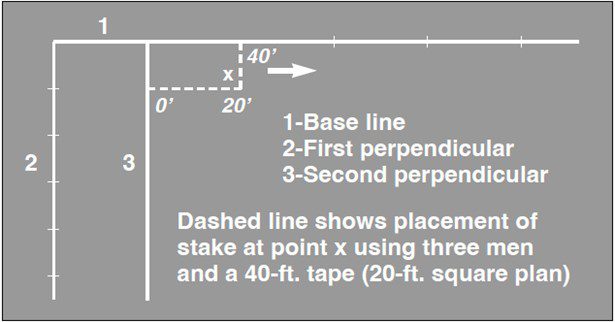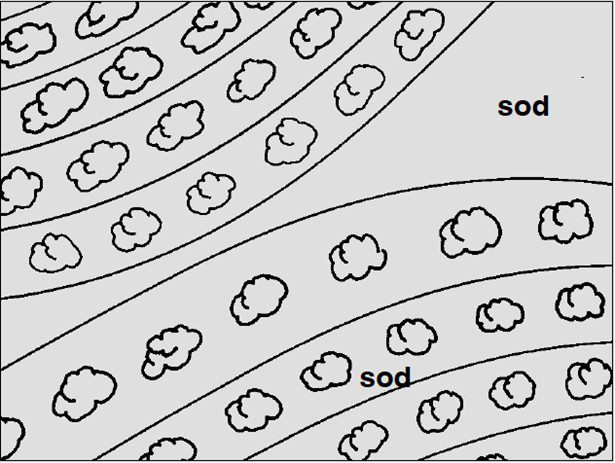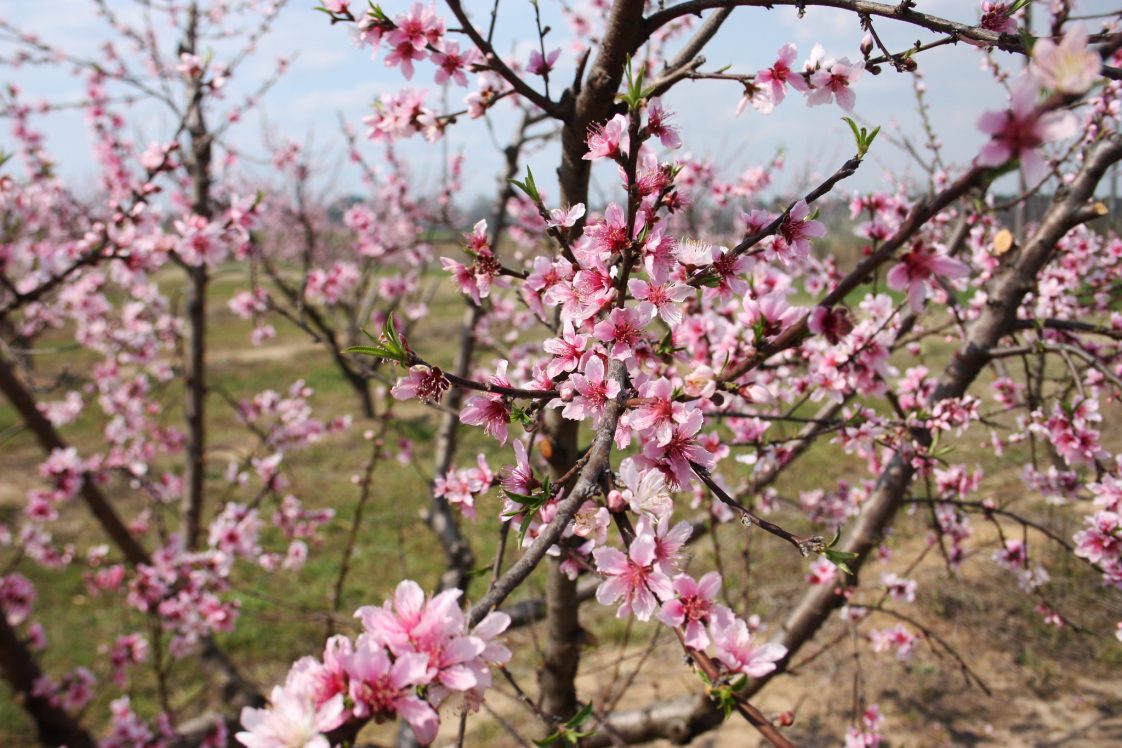Crop Production

Good site preparation and layout play a crucial role in the successful establishment of fruit plantings. Eliminating potential problems before planting helps minimize future costs and effort associated with crop management practices, ensuring a more efficient and sustainable investment in orchard development.
Preparing the Site
Consider the following recommendations for site preparation:
- Sample for nematodes. If nematodes are found, this site may have to be avoided until it can be placed in a grass or other plant rotation for 1 or more years. No chemicals are currently registered for nematode management in home gardens. During the summer months, home gardeners may try solarization by using plastic to cover the site. Commercial growers can use nematicides as well as nonchemical control methods.
- Remove stumps, large rocks, and other debris from the site.
- Plow and subsoil the area to remove as many roots and smaller rocks as possible. Roots left in the soil can contribute to root-rot problems in fruit trees.
- Test the soil, and apply lime, phosphorus, and other fertilizer nutrients according to soil test recommendations. Apply lime and fertilizer if needed in the fall. Lime is seldom needed for blueberry plantings because blueberries require an acid soil with a pH of 4.0 to 5.5.
- Apply about 50 to 75 percent of the lime, phosphorus, and other elements on the surface and incorporate into the soil.
Determining Home Orchard Size
Not all people enjoy all fruits. Evaluate your family situation and plant those fruits that best meet your needs. The number of plants that will supply the annual needs for fresh and processed fruit for a family of five are identified in table 1.
If you choose to produce several fruit crops, you will probably have more fruit than your family can use. For example, just five semivigorous apple trees 10 years of age can easily produce 35 bushels annually. Since one bushel of apples weighs 45 pounds and per capita consumption per year is 16 pounds, a family of five will need 80 pounds or just under two bushels. Accordingly, two trees should be enough to meet this need. Plant only what you enjoy eating, and avoid the chore of caring for more plants than you really need.
Table 1. Number of Fruit Plants to Meet Annual Needs of a Family of Five
| Fruit Crop | Number of Plants |
|---|---|
| Tree Fruit | |
| Apple, Semidwarf | 2 to 5 |
| Pear and Asian Pear | 2 to 5 |
| Peach and Nectarine | 5 to 8 |
| Plum | 5 to 8 |
| Persimmon | 3 to 4 |
| Fig | 3 to 5 |
| Small Fruit | |
| Bunch Grape | 4 to 6 |
| Muscadine Grape | 4 to 6 |
| Blackberry, Upright or Trailing | 12 to 15 |
| Raspberry | 12 to 15 |
| Blueberry | 8 to 12 |
| Strawberry | 200 to 300 |

Figure 1. Laying out a square or rectangular orchard.
Laying Out the Tree Fruit Orchard
After preparing the site and determining the size of the orchard, you must next decide on a plan or arrangement for the orchard. For a fairly level site, use the rectangular or square design. If the land is rugged and steep, follow the contour of the hillside.
The square and rectangle are the most commonly used systems for laying out orchards (figure 1). In the square design, a tree is set in each corner of a square, using the recommended spacing. The rectangular design is used to set trees at unequal distances. For example, with dwarf apples, use a 9-foot x 15-foot rectangle to set trees 9 feet apart in one direction and 15 feet apart in the other. Row orientation should be north to south for best light interception and shorter drying time after rain events.

Figure 2. Contour planting using parallel rows or terraces should be used where soil erosion may be a problem.
Most growers prefer to arrange their orchards in straight rows to make working easy, but in some cases, contour systems may be needed (figure 2). On steep or rugged sites, contour systems help prevent or reduce erosion and conserve moisture. Since rainfall, slope, soil, and other conditions vary in different parts of the country, growers use various arrangements. At present, growers use terraces in contour systems when additional erosion control is needed.
In commercial operations, no matter which orchard layout is used, a minimum 25-foot to 30-foot turnaround should be left at the ends of rows to allow easy movement of equipment and machinery.
Laying Out Small Fruit Plantings
Many of the same guidelines for laying out a tree fruit orchard also apply to small fruit plantings, such as grapes, blackberries, and blueberries. Straight rows are preferred, although the contour system and terraces, where needed, work equally as well. Strawberry plantings are laid off with tractors, using beds spaced 6 feet apart when plasticulture is used. Matted-row systems are generally laid off using 3 1⁄2- to 4-foot rows with or without bedding.
Determining Planting Distances
Proper spatial arrangement is essential in new plantings. Aligning the trees carefully not only improves the orchard’s appearance, but it also makes orchard operations easier.
Individual tree or plant sites can be indicated with a stake. Use the recommended planting distances in table 2 to help determine spacing of trees within the layout you plan to use for planting.
The number of plants required in an acre can be determined by multiplying the distance between trees in the row by the distance between rows and then dividing the figure into the number of square feet in an acre (43,560 square feet).
Table 2. Recommended Planting Distances
*Geneva series (G.) rootstocks are recommended for their fire blight resistance.
| Rootstock Type* | Planting Distance (in feet) |
|---|---|
| Tree Fruit | |
| Apple, Semidwarf G.969 | Nonspur: 12 x 20, 15 x 20 |
| Apple, Freestanding M7A, G.30 | Spur: 9 x 18, 10 x 20 |
| Apple, Semidwarf, Trellised, M26, M7A, G.935, G.202 | Spur: 5 x 12, 8 x 12 |
| Apple, Dwarf, Trellised, M9, G.11, G.41, G.214 | Nonspur: 8 x 12, 9 x 14 Spur: 5 x 12, 7 x 14 |
| Pear, Common (Hard) and European Hybrids | 20 x 20, 25 x 30 |
| Peach | Guardian: 15 x 20 MP-29: 12 x 18 |
| Plum | 20 x 20, 25 x 25 |
| Cherry | 20 x 20, 15 x 20 |
| Oriental Persimmon | 12 x 20, 15 x 20 |
| Fig | 15 x 15, 15 x 20 |
| Small Fruit | |
| Bunch Grape | 8 x 12 |
| Muscadine Grape | 20 x 12 |
| Blackberry | Space rows 10 to 12 feet apart. Space rooted plants 2 to 4 feet apart or root pieces (erect types) 1 1⁄2 feet apart within rows. |
| Raspberry | 4 x 10, 6 x 10 |
| Blueberry, Highbush | 5 x 10, 6 x 10 |
| Blueberry, Rabbiteye | 6 x 12 |
| Blueberry, Southern Highbush | 3 x 12 |
| Strawberry | Hill plasticulture system: 2-row, 6-foot bed with 26 to 30-inch crown, Space plants 12 inches apart within and between rows. Matted Row system: 1 1⁄2 x 3 1⁄2 |
 Revised by Elina Coneva, Extension Specialist, Professor, Horticulture; William East, Regional Extension Agent, Commercial Horticulture; David Lawrence, Regional Extension Agent, Commercial Horticulture, and Edgar Vinson, Assistant Extension Professor, Horticulture, all with Auburn University. Originally written by Arlie Powell, former Extension Horticulturist; David Himelrick, former Extension Horticulturist; William Dozier, former Professor; and David Williams, former Extension Horticulturist, all in Horticulture with Auburn University
Revised by Elina Coneva, Extension Specialist, Professor, Horticulture; William East, Regional Extension Agent, Commercial Horticulture; David Lawrence, Regional Extension Agent, Commercial Horticulture, and Edgar Vinson, Assistant Extension Professor, Horticulture, all with Auburn University. Originally written by Arlie Powell, former Extension Horticulturist; David Himelrick, former Extension Horticulturist; William Dozier, former Professor; and David Williams, former Extension Horticulturist, all in Horticulture with Auburn University
Revised December 2023, Fruit Culture in Alabama: Site Preparation and Layout, ANR-0053-I

